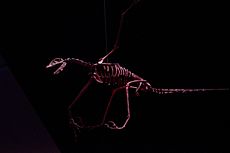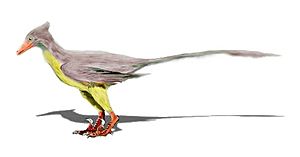Rahonavis facts for kids
Quick facts for kids RahonavisTemporal range: Upper Cretaceous, 70 million years ago
|
|
|---|---|
 |
|
| Scientific classification | |
| Kingdom: | |
| Class: | |
| Superorder: | |
| Order: | |
| Suborder: | |
| Family: | |
| Genus: |
Rahonavis
|
Rahonavis was a fascinating feathered dinosaur that lived about 70 million years ago. This was during the Upper Cretaceous period. Its fossils were found in what is now northwestern Madagascar. Rahonavis was a small predator, only about 70 centimetres (2.3 ft) long. It had a special sickle-shaped claw on its second toe, just like the famous Velociraptor. This dinosaur was very bird-like, making it a unique discovery! Scientists found only a partial skeleton of Rahonavis in a quarry.
When scientists first studied Rahonavis, they noticed something special. Its forearm bone, called the ulna, had small bumps. These bumps are called quill knobs. Modern birds have quill knobs where their flight feathers attach. This made scientists think Rahonavis was an early bird.
However, the rest of its skeleton looked more like a type of dinosaur called a dromaeosaur. These dinosaurs are known for their sharp claws and often feathered bodies. Many experts now believe Rahonavis was closely related to other dromaeosaurs. Some scientists think it was part of a group called Unenlagiinae. This group includes dinosaurs like Unenlagia and Buitreraptor from South America.
Rahonavis was about the size of a modern raven. It was also a bit larger than Archaeopteryx, another famous early bird. Even though many pictures show Rahonavis flying, scientists are not completely sure it could.
There was even a debate about the bones found. Some researchers wondered if the forearm bones, with their quill knobs, actually belonged to a different animal. They thought Rahonavis might be a "chimaera." This means it could be a mix of bones from a bird and a dromaeosaur. This idea came up because another ancient bird, Vorona berivotrensis, was found nearby.
However, many scientists, including those who first described Rahonavis, believe all the bones came from one animal. The wing bones were found very close to the rest of the skeleton. According to Luis M. Chiappe, one of the scientists who studied it, all the bones were found in a space smaller than a piece of paper.
Chiappe believed Rahonavis could probably fly. He noted that its ulna bone was strong and large compared to Archaeopteryx. The clear quill knobs also suggested it had big, powerful wings. Its shoulder bones showed signs of special connections. These connections would allow the independent movement needed for flapping flight. Chiappe concluded that Rahonavis could fly, but it might have been a bit clumsy in the air compared to birds today.
Images for kids
See also
 In Spanish: Rahonavis ostromi para niños
In Spanish: Rahonavis ostromi para niños



